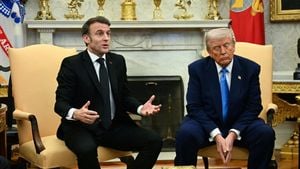Russian President Vladimir Putin recently extended an intriguing offer to the United States, proposing collaboration on the exploration of Russia's rare earth metals, along with the potential supply of aluminum to the US market. This announcement, which signals a notable shift in diplomacy, arrived shortly after US President Donald Trump highlighted the likelihood of significant economic transactions between the two nations.
During his statements, Putin emphasized Russia's readiness to forge partnerships, not just with governmental structures, but also with American corporations interested in working together on these mining and industrial projects. "We are, by the way, ready to offer (joint projects with) our American partners... if they are interested in working together," he remarked during discussions broadcasted on state television.
This proposal opens dialogue on utilizing Russia's rich natural resources, particularly when one considers the strategic importance of rare earth metals. These materials are pivotal for modern technology, facilitating the production of electric vehicles, mobile phones, and various electronic systems reliant on these metals.
Putin's recent comments pointed out, "I want to stress there is certainly much more of this type of resources than Ukraine," highlighting Russia's competitive advantage over neighboring countries like Ukraine. He mentioned the US Geological Survey's recognition of Russia as having the fifth largest reserves of rare earth metals globally, estimated at around 3.8 million metric tons.
Currently, Russia extracts only about 2,500 tons of rare earth concentrate each year and has pointed out inadequate processing capabilities, which may pose challenges for future agreements with the US. Nevertheless, Putin assured audiences of the potential for partnerships to develop this sector, stating, "Our joint projects could also extend to the energy sector," previewing a broader scope for collaboration.
Aluminum was also on the agenda, with Putin offering to supply up to 2 million tons annually, contingent on the reopening of trade conditions, as prior sanctions have shaped current trade dynamics. Before introducing prohibitive tariffs, Russia provided as much as 15% of the US aluminum imports. This dramatic change signifies not only the economic interdependence between the US and Russia but also potential geopolitical strategy.
The discussions also took place against the backdrop of increasing global competition for these dwindling resources. Not only the US, but countries worldwide are scrambling to secure their supply chains—especially for materials required for high-tech and sustainable energy products. The emergence of such agreements is timely as the US looks to reduce reliance on Chinese suppliers for these pivotal materials.
While these potential agreements present intriguing opportunities, they also reflect the complicated history and current state of US-Russia relations. Increasing cooperation between the nations could be perceived as unsettling by many, particularly considering the long-standing tensions over various geopolitical conflicts, including the situation in Ukraine.
Despite these concerns, economic forecasts have shown positive signs, hinting at mutual benefits for both nations as discussions advance. By exploiting Russia's abundant resources, the US could build its technology and manufacturing sectors, which would be particularly advantageous as the world pivots toward green technology and electric power.
Focusing on the strategic aspects, the Russian leader has suggested significant investments—approximately $15 billion—in potential projects. With energy partnerships on the table, there’s potential for the participation of American companies eager to engage with Russian resources.
One must ponder how these developments could reshape the overarching dynamics of international relations. With Putin and Trump discussing possibilities, one wonders if this could lead to thawing relations or if it would merely function as another chapter of political maneuvering.
Indeed, as the world vacillates between cooperation and competition, these discussions reflect the broader tendencies of nations seeking to balance their interests with changing geopolitical landscapes. The ramifications of these discussions could be far-reaching, echoing through rankings of global power and influence.
These possible partnerships could not only bolster the US’s supply chain but position both countries as leaders in the production of rare earth metals and aluminum, all key players on the chessboard of global economics.
With this intriguing offer on the table, the future of US-Russia relations and their economic ties is poised to be exciting—perhaps even unpredictable—in the coming months. For both nations, the question remains whether the will to collaborate can overcome past animosities and lead to sustained growth and mutual benefits.
Coordination over projects on rare earth metals and aluminum, especially when viewed through the lens of significant investment and market opportunities, suggests there’s more than just rhetoric at play. If followed through, such initiatives could mark the start of a new chapter of cooperation, driven by necessity and strategic foresight.



